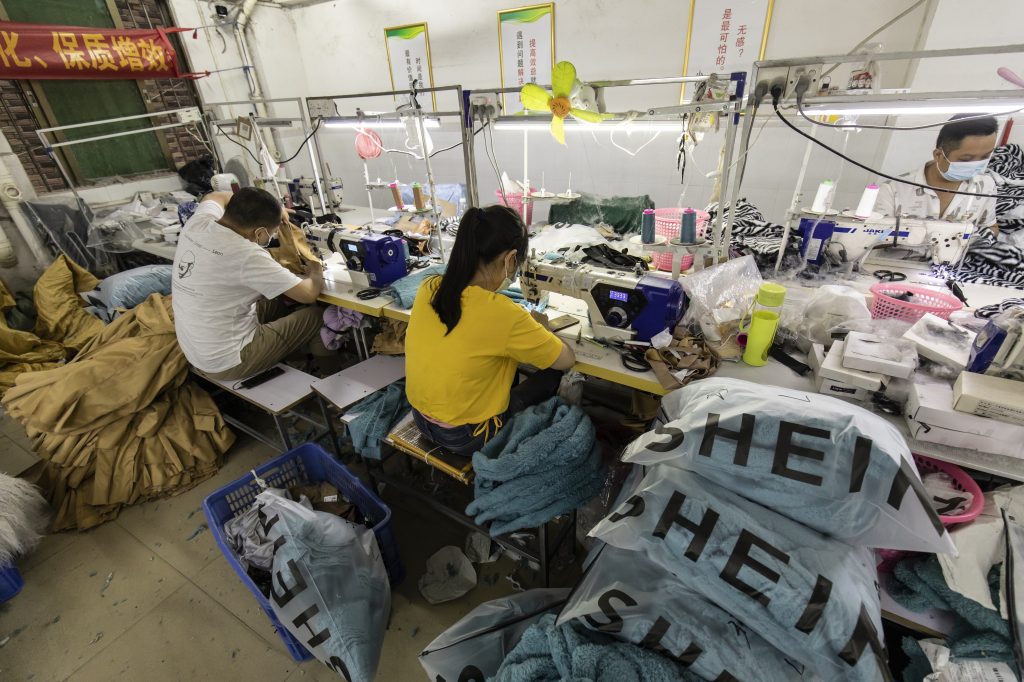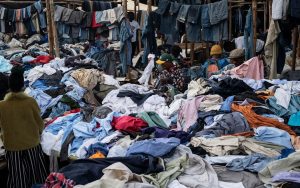7 The New Fast Fashion: The Gentrification of Thrifting
Livvie Hurley
When I was growing up, wearing secondhand clothing was my deepest, darkest secret. I thought it was so embarrassing that I wore used clothes to my school that was in an affluent area. I didn’t tell anyone that my mom was the general manager of two different secondhand clothing stores; first a children’s store and then a teen/young adult store. I even still felt embarrassed telling my friends at school that I got a job with my mom at the store she managed, Plato’s Closet, at age 16. It wasn’t until I got to college that thrifting became something cool. Now people think it’s awesome that I have the benefit of finding unique pieces with a discount at my job. Thrifting gaining traction should be an amazing shift in consumer behavior: say no to fast fashion and reuse the clothes that are already in circulation, right? The problem is that thrifting is a trend, and trends do not last forever. Although buying clothing in a secondhand setting seems to be a solution to the detrimental effects of fast fashion, it actually has encouraged a similar overconsumption mindset in consumers.Although buying clothing in a secondhand setting seems to be a solution to the detrimental effects of fast fashion, it actually has encouraged a similar overconsumption mindset in consumers.
What is Gentrification?
The roots of gentrification stem from the housing market. Gentrification of a poor neighborhood happens when rich people move in, refurbish or improve the housing, raise the rent, and push out the original tenants who can no longer afford it. A similar process has happened with thrifting. The current state of the used clothing market decreases supply and opportunities for lower-income Americans to purchase clothing. To put it in an economic perspective, lower classes only have a select supply of clothing to choose from due to their financial limitations. Middle classes have more options, and the highest classes have the most. Now that thrifting has become a trend, the middle class and even upper middle class have turned to thrifting to satisfy their overconsumption needs. The whole market now revolves around this demand and price has skyrocketed as supply has fallen. To understand this new phenomenon, we must first go back to the original problem: fast fashion.

The Effects of Fast Fashion
Initially applauded as a great business model that offers more choice to the consumer, fast fashion is now largely frowned upon in society for the ethical and environmental dilemmas it raises. The biggest problem of all arguably is the amount of water it takes to produce clothing. Every year, fast fashion practices consume about 79 trillion liters, which is equivalent to covering the entire surface of California in over half a foot of water (Bailey, K., Basu, A., & Sharma, S.). Dying the material that goes into clothing is also dangerous because runoff water with toxic dyes can be released into local water systems (Bick, R., Halsey, E. & Ekenga, C.C.). The practices that support the fast fashion business model aren’t exactly ethical. Fast fashion relies on outsourcing labor to countries with cheap minimum wages and iffy labor laws in order to keep prices down. One of those countries is China, where 65% of the world’s clothing is made (Tidswell, E.). The minimum wage in Beijing is currently $3.70 an hour in U.S. dollars, which is on the higher end compared to other cities in China (Zhou, Q.).

Another environmental and social implication of fast fashion is the amount of textile waste that is produced from it. More specifically, “The average American throws away approximately 80 pounds of clothing and textiles annually, occupying nearly 5% of landfill space” (Bick, R., Halsey, E. & Ekenga, C.C.). What doesn’t get thrown away is sold and exported from secondhand thrift stores to other countries, like countries in Africa. What doesn’t sell in Africa pollutes their environments and takes up space in their landfills. Fast fashion is the root of the problem with the sheer volume of clothing that is produced, which many people know. But what many people may not know is that their “charitable” donation of unwanted clothing may actually be doing more harm than good.
“Mitumba”
Why is sending clothing overseas to Africa so bad? Third-world countries probably need our help, right? They actually aren’t in as much need as we think. Many Africans wear mitumba, clothing thrown away by Americans and Europeans (Rivoli, P.). Because the Global North produces more clothing than we can keep up with, Africans can afford to dress nicely. What starts in the elite classes will always eventually trickle down to lower classes, and this happens in the case of clothing, too. Even the habits of the women there now resemble the habits of the developed countries: they’re picky about the clothes they wear. It’s estimated that there are seven times as much women’s clothing in good condition than men’s in the world, which consequently allows African women to cast out up to 90% of clothing still in good condition (Rivoli, P.).

Mitumba has hurt the domestic textile industries of African countries, as they can no longer compete with the enormous volume of secondhand clothing that comes in. More than 30 countries in the world have banned the import of used clothing (Rivoli, P.). The environment and economy of the secondhand clothing industry in other countries cannot withstand the ways of fast fashion forever.
Thrifting: A Solution or Another Problem?
Now that people know how problematic the volume that fast fashion produces is for the environment, there has been a movement to switch to secondhand clothing or build a “time capsule wardrobe.” A time capsule wardrobe is made up of good quality basics that will last a long time and withstand trends. Theoretically, if you have all the basics, you can accessorize with a few statement pieces and build many different outfits just by layering. In reality, due to the oversaturated media climate we have lost sight of what a “basic” really means and are still buying way too much. TikTok is a huge outlet for influencers to market right now, and these influencers market by way of “hauls” which is are videos showing items purchased during a shopping trip. Haul after haul you hear people excuse their spending because they needed more “basics” for the new season. It defeats the purpose of calling it a basic to have to buy it at least four times a year. This also encourages overconsumption in the people watching the hauls, making them think they need this newer, cuter “basic” for their fall wardrobe.

The other issue lies in the secondhand clothing market. I see it every day at my job at Plato’s Closet when I’m at the buy counter going through people’s clothes they are trying to sell. Fast fashion retailers like Shein have changed trend cycles into a weekly or almost daily turnover rate. Those microtrends are what people are donating or selling, and who is going to want it now at a secondhand store when it’s not in style anymore? That print that we thought was so cute and trendy last week is now deemed ugly this week. At Plato’s we can barely offer a lower price than Shein’s retail price due to our system that generates the prices. People complain about the pricing we have but also complain that we even have so much Shein or other low quality brands. Plato’s Closet is a supply-driven business model. If the world wants to see less Shein in secondhand stores, we need to start at the source and stop buying from Shein. It is difficult to solve the problem at the secondhand level when not everyone is willing to stop buying in bulk from places like Shein so often.
The Gentrification of Thrifting
What used to be an affordable way for lower-income families to find clothing has turned into a money-hungry resell market. What used to be an affordable way for lower-income families to find clothing has turned into a money-hungry resell market. In recent years, more young people are now turning to secondhand stores to purchase their clothing. According to research from Crystal Ma and Greg Riggio, “40% of those under the age of 24 have bought second hand in 2019 as compared to just 3 years prior in 2016 with an almost 20% increase. From the period of 2017 to 2019, the top ten clothing and fashion apps have begun to include resell apps, with Depop and ThredUP (two popular thrift resale apps) just entering the top ten list for the first time in 2019 (Briskman, 2019).” This research was done before the COVID-19 pandemic, the period when resale apps exploded in popularity due to many retail stores shutting down in 2020.

The first part of the problem is that the overconsumption mindset did not change when people started to go thrifting, it only became more excusable. People can write it off as sustainable even if they do not wear all of the secondhand clothes they are buying. I have fallen victim to this mindset, too. I buy and sell clothes constantly at my job because of how accessible it is for me to do so. Most of my clothes become boring to me after a couple of wears, and there are still many pieces in my closet that I have not worn yet. It’s easy for me to preach against fast fashion by claiming that I do not monetarily support these businesses, but I am still part of the overconsumption mindset that a lot of Americans are so used to.
The second part of the problem is the business model that has been created from the resale market. With resale apps gaining popularity, there is a whole new job market for those who wish to make thrifting and reselling their full time job. A vintage piece that someone found at a thrift store can be marked up enormously and resold on apps like Depop or Poshmark. Instagram has been a huge market for people to resell clothes as well. All it takes is knowledge of brands and a little bit of fashion history for someone to profit from this industry. People take these apps very seriously. For example, the creator of Depop received a death threat because someone did not get their item in time for Christmas (Picciotto, R.). We’re conditioned to only accept the “best” price for something, which is why these apps are so profitable. We think we’re getting a great deal on a unique item that was actually found at a thrift store and marked up over 100%.We think we’re getting a great deal on a unique item that was actually found at a thrift store and marked up over 100%.
A real-life case study of this is a reseller that is a regular at Plato’s Closet Bloomington, where I work. She comes in multiple times a week to look for top name brands that she will in turn mark up and sell on her Instagram account. Customers have complained about her doing so because it’s obvious that she’s not buying for herself when she spends hundreds of dollars at a time but doesn’t try anything on. We’ve even had to implement strategies to try and let other people have a chance to buy the higher-quality, name-brand products that they might actually wear and love. The people all over the country that follow her Instagram probably think they’re getting a great deal on a name-brand item, but really she’s taking away the opportunity that someone could have found that piece at an affordable price.

The question that many people fail to consider is how does this behavior affect underserved communities? Since thrifting is a trend right now, many young people are turning to places like Goodwill and Salvation Army to buy clothes. In the same research done by Ma and Riggio, the survey results revealed that people have noticed a decrease in stock at these stores and an increase in price (Ma, C., & Riggio, G.). These places were meant to be the most accessible and affordable place for lower-income individuals to get their clothes, and it has turned into a gentrified nightmare of a system. Goodwill has raised their prices in recent years, sometimes even pricing items from fast fashion brands like Shein more than their original cost (Hanbury, M.). While the pricing varies based on location, in 2020 a men’s coat would be priced at $8 versus $10 today at one location (Goodwill). This doesn’t take into account brand, which Goodwill does pay attention to and adjust accordingly. Corporations are set up around what will accumulate the highest profit, so they will respond to demand. For as long as thrifting is a trend and overconsumption continues, prices will be higher and will exclude the lower class.
Conclusion
We have too many clothes in this country. The problem is not only the corporations that perpetuate fast fashion or the people that buy from fast fashion companies. The problem is our mindset as Americans, which is that we feel like we need everything. We are in love with the abundance of choice we have, and no matter where we get our clothes from, that mindset seems to follow. Thrifting resembles a solution, but in reality it’s a complex issue that requires more than just changing where we choose to buy our clothes. The solution is not only to switch to secondhand clothing, but to buy less of it. In turn, we should keep more and donate less of our clothing that might end up in an African landfill. Build your real time capsule wardrobe, not just a trendy one.
References
Bailey, K., Basu, A., & Sharma, S. (2022). The Environmental Impacts of Fast Fashion on Water Quality: A Systematic Review. Water, 14(7), 1073. MDPI AG. Retrieved from http://dx.doi.org/10.3390/w14071073
Bick, R., Halsey, E. & Ekenga, C.C. The global environmental injustice of fast fashion. Environ Health 17, 92 (2018). https://doi.org/10.1186/s12940-018-0433-7
Goodwill (n.d.). Price List. Goodwill Industries of the Southern Piedmont. https://goodwillsp.org/shop/price-list/
Goodwill (n.d.). Valuation Guide for Goodwill Donors. https://www.goodwill.org/wp-content/uploads/2020/03/donation_valuation_guide.pdf
Hanbury, M. (2023, March 21). Shoppers say secondhand stores like Goodwill are getting too expensive as Gen Z makes thrifting cool. Business Insider. https://www.businessinsider.com/shoppers-say-goodwill-salvation-army-pricey-as-thrifting-becomes-cool-2023-3
Ma, C., & Riggio, G. (2021). An Examination of the Effects on Low-Income Communities by the “Takeover” of Thrift Store Clothing by Resellers . Journal of Student Research, 10(2). https://doi.org/10.47611/jsrhs.v10i2.1784
Picciotto, R. (2023, March 24). Secondhand resale is getting cutthroat as platforms such as Depop and Poshmark boom. CNBC. https://www.cnbc.com/2023/03/24/depop-poshmark-secondhand-resale-cutthroat.html
Rivoli, P. (2014). The travels of a t-shirt in the global economy : An economist examines the markets, power, and politics of world trade. new preface and epilogue with updates on economic issues and main characters. John Wiley & Sons, Incorporated.
Tidswell, E. (n.d.). ASKING THE BIG QUESTION: WHERE DO CLOTHING BRANDS MANUFACTURE?Good Maker Tales. https://goodmakertales.com/where-do-clothing-brands-manufacture/
Zhou, Q. (2023, November 7). A Guide to Minimum Wages in China in 2023. China Briefing. https://www.china-briefing.com/news/minimum-wages-china/#:~:text=Minimum%20wages%20in%20China%20continue,%2FUS%243.7%20per%20hour
